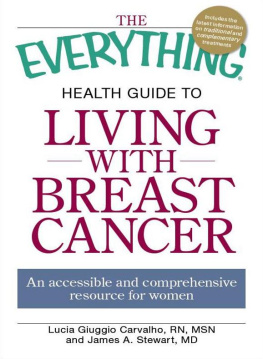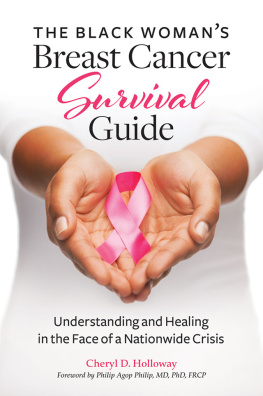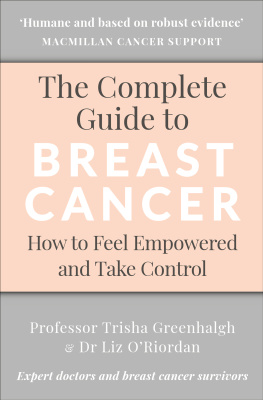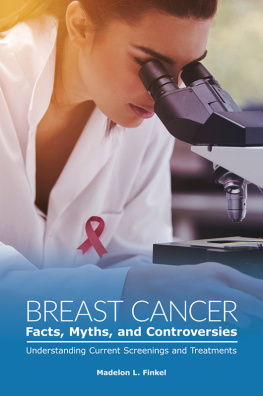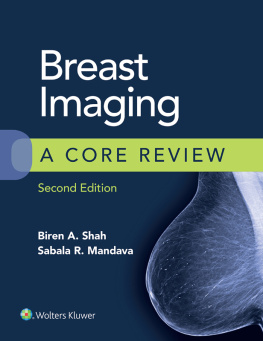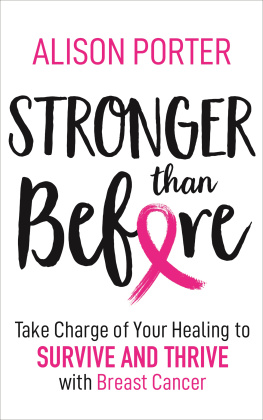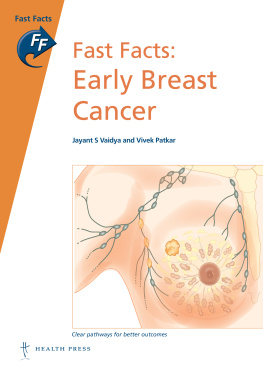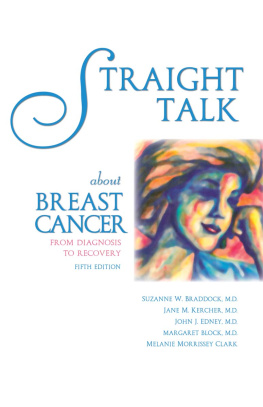Terry J. Priestman - Breast Cancer: Your Treatment Choices
Here you can read online Terry J. Priestman - Breast Cancer: Your Treatment Choices full text of the book (entire story) in english for free. Download pdf and epub, get meaning, cover and reviews about this ebook. year: 2013, publisher: John Murray Press, genre: Religion. Description of the work, (preface) as well as reviews are available. Best literature library LitArk.com created for fans of good reading and offers a wide selection of genres:
Romance novel
Science fiction
Adventure
Detective
Science
History
Home and family
Prose
Art
Politics
Computer
Non-fiction
Religion
Business
Children
Humor
Choose a favorite category and find really read worthwhile books. Enjoy immersion in the world of imagination, feel the emotions of the characters or learn something new for yourself, make an fascinating discovery.
- Book:Breast Cancer: Your Treatment Choices
- Author:
- Publisher:John Murray Press
- Genre:
- Year:2013
- Rating:4 / 5
- Favourites:Add to favourites
- Your mark:
- 80
- 1
- 2
- 3
- 4
- 5
Breast Cancer: Your Treatment Choices: summary, description and annotation
We offer to read an annotation, description, summary or preface (depends on what the author of the book "Breast Cancer: Your Treatment Choices" wrote himself). If you haven't found the necessary information about the book — write in the comments, we will try to find it.
The basic information needed to make informed choices about cancer care is covered in this book, including key facts about surgery, radiotherapy, chemotherapy, hormone therapy, targeted therapy and complementary treatments. There is also advice regarding advanced breast cancer.
Breast Cancer: Your Treatment Choices — read online for free the complete book (whole text) full work
Below is the text of the book, divided by pages. System saving the place of the last page read, allows you to conveniently read the book "Breast Cancer: Your Treatment Choices" online for free, without having to search again every time where you left off. Put a bookmark, and you can go to the page where you finished reading at any time.
Font size:
Interval:
Bookmark:
Breast Cancer Care
513 Great Suffolk Street
London SE1 0NS
Tel.: 0845 092 0800
Website: www.breastcancercare.org.uk
The helpline is staffed by specialist breast-care nurses; and there is printed information for anyone affected by breast cancer. The organization also provides a support service where women with breast cancer can be put in touch with a trained individual who has had personal experience of the condition.
Cancer Research UK
Angel Building
407 St John Street
London EC1V 4AD
Tel.: 020 7242 0200
Helpline: 0808 800 4040 (9 a.m. to 5 p.m., Monday to Friday)
Website: www.cancerresearchuk.org
Macmillan Cancer Support
89 Albert Embankment
London SE1 7UQ
Tel.: 020 7840 7840
Helpline: 0808 808 00 00 (9 a.m. to 8 p.m., Monday to Friday)
Website: www.macmillan.org.uk
In addition to funding cancer nursing services and offering valuable advice on coping with the financial consequences of cancer, this organization provides a number of very informative publications on breast cancer. The helpline is staffed by experienced nurses who can give further information and support.
Maggies Centres
First Floor
One Waterloo Street
Glasgow G2 6AY
Tel.: 0300 123 1801
Website: www.maggiescentres.org
Located throughout the country, Maggies Centres (nine at present, with more planned) are places to turn to for help with any of problems related to cancer. Under one roof you can get information, advice about benefits, and emotional support. You dont have to make an appointment, and everything is free of charge. There is also a specific online centre for those who are not able to access one of the other centres. The website contains extensive information on how the centres can help. The job of the professionals at Maggies is to listen to you to help you find out what you want and give you what you need to help yourself.
Terry Priestman is Consultant Oncologist and Honorary Senior Clinical Lecturer at the University of Birmingham. He is also Medical Editor for the charity Macmillan Cancer Support. He is a former Dean of the Faculty of Clinical Oncology at the Royal College of Radiologists, and has written more than a hundred papers for the medical press. He is also the author of Coping with Breast Cancer (2006), Coping with Radiotherapy (2007), Reducing Your Risk of Cancer (2008), The Cancer Survivors Handbook (2009) and Coping with Chemotherapy (second edition, 2011) all published by Sheldon Press.
When you are first diagnosed with breast cancer it is almost always in a breast clinic at the hospital, where all the staff there, the doctors and nurses, will be specialists in breast cancer. This is obviously a good thing because it is important for you to get expert care and attention. But it does mean that although the people on the clinical team have years of experience of dealing with breast cancer, they will sometimes forget that you dont know a lot about what breast cancer actually is and how it behaves, and they will often use words or talk about ideas that you simply dont understand. This can leave you confused and uncertain, which is a bad thing for at least two reasons: first, it adds to the fear and concern you will almost certainly have when you are first told you have cancer; and second, if, as is increasingly common these days, you are invited to make choices about your treatment this can be very difficult if you dont really understand the basic facts to help guide you through those choices. This chapter describes some of the key facts about cancer in general and breast cancer in particular in the hope that it will shed light on some of the things that doctors and nurses might have said that were puzzling or just plain incomprehensible.
Our bodies are made up of billions of cells. Throughout life these cells will wear out and die. So every day we make millions of new cells to replace the old cells that are lost. This process is very finely controlled so that exactly the right number of new cells is made to balance the old cells that have gone. But sometimes things go wrong and too many new cells are made. If this continues then, over time, a swelling or growth will develop in a particular part of the body. These growths are called tumours. Tumours may be either benign or malignant. If the tumour is malignant then it is a cancer.
Most cancers begin as a single growth in a particular part of the body. This is called the primary cancer. The primary cancer is also described by the part of the body where it is located; so a cancer that begins in the breast is a primary breast cancer and a cancer that begins in the lung is a primary lung cancer. Cancers can occur in almost any part of the body and there are more than 200 different types.
There are two important differences between a benign tumour and a cancer. First, as a cancer grows it eats into and destroys the surrounding tissue. Doctors often talk about this as invasion, so a cancer is an invasive tumour. Benign tumours may grow to a large size but they do not invade the surrounding tissues and organs; they may push them out of the way or squeeze them but they do not eat into them. This means that if someone has an operation to take away a benign tumour then it can usually be removed quite easily. But if it is a cancer it will be much more difficult to see where the growth ends and normal tissue starts, so in order to take it away completely the surgeon will have to remove a margin of normal tissue around the cancer.
The second difference between a benign tumour and a cancer is that cancers can spread to other parts of the body but benign tumours cannot. This means that tiny clumps of cells can break away from a primary cancer and be carried by the lymph vessels or the bloodstream to nearby lymph glands or to organs like the liver, lungs, brain or bones. When a cancer spreads elsewhere these new cancers are called secondary cancers (secondaries or metastases). So if a primary breast cancer spreads to the lungs then the tumours in the lungs will be secondary breast cancers, or breast cancer metastases.
If a breast cancer spreads to the lungs then the secondary cancers will be made up of breast cancer cells and will behave like breast cancer, not like lung cancer. This can be quite confusing. For example, the media will often report that a particular celebrity has lung cancer when what he or she actually has is a secondary cancer metastatic cancer that has spread to the lungs from a primary growth in another part of the body. Making this distinction is important because the behaviour, treatment and outlook for primary and secondary cancers are very different.
The lymph vessels are tiny thread-like tubes that drain colourless fluid called lymph from all the organs and tissues in the body. These vessels carry the lymph from a particular organ or tissue into nearby lymph nodes (which are also known as lymph glands). These are tiny bean-shaped structures that are normally quite small and difficult to see but that may become very enlarged and swollen if there is an infection or if a nearby cancer spreads into them.
The network of lymph vessels and lymph nodes runs throughout the body. Most of the lymph from the breast drains to lymph nodes in the armpit. The medical name for the armpit is the axilla, so doctors call these the axillary lymph nodes (). The first of these lymph nodes that the lymph vessels reach after leaving the breast is called the sentinel node. When a breast cancer spreads through the lymph system, the sentinel node is almost always the first lymph node to be affected.
Font size:
Interval:
Bookmark:
Similar books «Breast Cancer: Your Treatment Choices»
Look at similar books to Breast Cancer: Your Treatment Choices. We have selected literature similar in name and meaning in the hope of providing readers with more options to find new, interesting, not yet read works.
Discussion, reviews of the book Breast Cancer: Your Treatment Choices and just readers' own opinions. Leave your comments, write what you think about the work, its meaning or the main characters. Specify what exactly you liked and what you didn't like, and why you think so.



